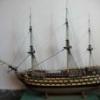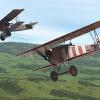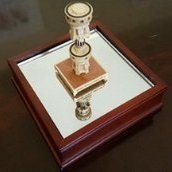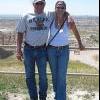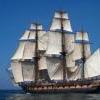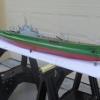Supplies of the Ship Modeler's Handbook are running out. Get your copy NOW before they are gone! Click on photo to order.
×
-
Posts
4,873 -
Joined
-
Last visited
Reputation Activity
-
 gjdale got a reaction from hamilton in 1949 Chris-Craft 19' Racing Runabout by gjdale - FINISHED -Dumas - 1:8 Scale - RADIO
gjdale got a reaction from hamilton in 1949 Chris-Craft 19' Racing Runabout by gjdale - FINISHED -Dumas - 1:8 Scale - RADIO
Thanks Bug and Carl, and also to those who hit the "like" button.
To complete the Horn Ring, the spokes were silver soldered in place and the whole thing given an initial clean-up. In this picture, the square cross-section of the rim is evident, as is that of the spokes.
All components of the wheel assembly are now ready for final clean-up and painting / plating.
The CutwaterI had previously made a mould to assist in making the cutwater but it turned out to be too small, so another mould was made. In making this mould, I first sprayed the bow with a spray-on / peel-off automotive plastic paint. This gave a nice smooth surface for the mould while ensuring plaster did not get stuck to the surface of the boat. This worked well and the peel-off paint behaved exactly as the manufacture claimed. I also embedded a couple of dowels in the plaster, with the ends passed through and epoxied into a scrap of 3/4” plywood. This provided a useful “handle” to hold the mould in a vice.
Paper patterns for the two halves of the cutwater were printed on sticky label paper and attached to a piece of 0.015” thick brass sheet. The brass sheet was itself attached to some thin plywood scrap with double-sided tape and the pieces were rough-cut on the scroll saw and then finish-shaped on the disc sander and spindle sander.
Following the lead of others in the RC Groups Forum, I embedded a number of 6-32 threaded inserts into the mould, and made some hold-downs from some scrap aluminium flat bar. At this point, I took a slightly different approach to the task of soldering the cutwater halves. I had read of others having problems with having sufficient solder on the internal side of the cutwater, and of course I’d read their solutions as well. I did a little further reading/research on soldering and decided that it might be possible to use the properties of the solder itself to solve this problem. The key point I noted was that solder will always flow towards the heat source. To make use of this, I placed one of the cutwater halves on the mould and then wedged a ribbon of solder “wire” partly under this half before placing the second cutwater half. This meant that the two halves of the cutwater were held in place with the ribbon of solder firmly touching each half. I then painted some flux along the outside of the join, and applied heat from my small butane torch, starting at one end and moving slowly but steadily along as the molten solder wicked through. This worked very well and I should have left well enough alone….. I decided to add a little extra solder in a couple of spots but really only succeeded in adding a few globs of molten solder to the outside faces. Oh well, a little extra clean-up!
In the next shot, you can see the solder on the internal join – prior to clean-up.
And finally, here’s a few beauty shots of the completed cutwater after a little clean-up with files and sandpaper.
I did a quick test-fit on the actual bow of the boat, and it fits neatly. The cutwater is now ready for plating and final fitting.
-
 gjdale got a reaction from hamilton in 1949 Chris-Craft 19' Racing Runabout by gjdale - FINISHED -Dumas - 1:8 Scale - RADIO
gjdale got a reaction from hamilton in 1949 Chris-Craft 19' Racing Runabout by gjdale - FINISHED -Dumas - 1:8 Scale - RADIO
Thanks again folks for all the kind comments and the "likes" - they really encourage me to keep striving.
A fairly major update today as I've completed manufacturing all the parts for the new steering wheel.
Wheel Building continued - the Hubs
If I thought that the hard part was over …..
The first step was to actually design my hub components. Although Kip had very kindly sent me a copy of his “chook scratchings” from the design process, I needed to make a couple of design changes to suit my slightly different approach (primarily the fact that the steering shaft will thread into the rear hub). I had several exchanges of email with Kip throughout this process and that was a huge help in getting my head around the task. Here is a copy of my own early chook scratchings.
From here, I decided to make up a set of CAD drawings of each component to further understand what I was attempting to do, and also as a useful check on my own measurements and calculations. Needless to say, there were many changes to both this diagram and the CAD drawings as the manufacturing process got underway – “no plan, no matter how good, survives first contact with the enemy!”
Once I had the design principles clearly in my head, the manufacturing process actually went quite smoothly…….for the most part. In fact, it went so well that I forgot to take many progress shots. In the next picture, I am drilling the banjo spoke holes into what will become the banjo spoke hub. This started as a piece of 5/8” brass rod, that was first bored to leave a wall thickness of 1.5 mm. The banjo spoke holes are all 0.5 mm in diameter and I managed to drill all twelve without breaking the drill bit. Ironically, the drill bit broke just as I was removing it from the mill.
The manufacturing process required some thought as to how to hold various pieces on the lathe while they were being turned and shaped and fitted to their final dimensions. After a bit of trial and error, I concluded that several mandrels of various key sizes, both solid and centre-bored, were the most useful thing to use. I found that gluing these temporarily with CA to the stock being machined held the piece securely while being worked. The parts were then separated by the judicious application of heat from the MAPP blow torch. Here is a shot of the various mandrels I used – in some cases a combination of two mandrels were required.
The rear hub was shaped by first cutting a series of steps (staircase effect) and then smoothing with a round file while still on the lathe. The Horn Ring Hub, Trim Piece and Cap piece required a radius on the end. The Radius Cutting attachment for the lathe worked a treat for these parts.
The Horn Ring itself is square in section and this was formed by using a 1/16” square brass tube. After first annealing with the MAPP torch, it was bent around the same wooden buck as used for the wheel rim. The buck was first turned down to the appropriate diameter, and I must confess here to having a couple of goes at this before I was satisfied with the size. As the tube is hollow, it allowed me to insert a piece of 0.8 mm brass rod inside and extending across the join. This really helped when silver-soldering the join closed. The piece was then returned to the rotary table on the mill and 0.85 mm holes were drilled at 120 degree intervals for mounting the spokes.
The spokes for the horn ring are also square in section and the same brass tube was used for this. By inserting a piece of the 0.8mm brass rod through the pre-drilled hole in the horn ring, right through the length of the spoke, and into the horn ring hub, the hole assembly becomes self-aligning.
The horn ring hub itself was probably the most difficult of all of these parts to make and I had three attempts at this before I was finally satisfied.
The Cap Piece, as well as having a radius turned on the end, also had a 1/32” slot cut with a slitting saw to receive the Throttle Lever, which itself was cut and filed from a piece of 1/32” brass flat bar.
The picture below shows all of these parts, starting with the Wheel Rim and a selection of banjo spokes at the rear, the Horn Ring, Horn Ring Hub and Horn Ring Spokes (temporarily mounted and ready for soldering), and then across the front from left to right are the Rear Hub (note the internal threading to receive the steering column), the Banjo Spoke Hub, the Trim Piece, and the Cap Piece, with the Throttle Lever in the foreground.
Putting some of these components together for the camera, here is a of shot of the Horn Ring assembly mounted on the Banjo Spoke Hub, mounted on the Rear Hub, with a temporary Steering Shaft.
And lastly, the same assembly with the stainless-steel sleeve that goes over the steering shaft.
That completes the manufacture of all components for the new steering wheel. The next job will be to solder the Horn Ring assembly together, and then chrome plate the Horn Ring assembly, Cap Piece and Throttle Lever. The other components will be painted an off-white (ivory) colour, and then the whole lot will be finally assembled.
Once that is done, I will return attention to making the cutwater….
-
 gjdale got a reaction from GuntherMT in 1949 Chris-Craft 19' Racing Runabout by gjdale - FINISHED -Dumas - 1:8 Scale - RADIO
gjdale got a reaction from GuntherMT in 1949 Chris-Craft 19' Racing Runabout by gjdale - FINISHED -Dumas - 1:8 Scale - RADIO
It's been a while since my last update - not because of a lack of work, but because of a lot of re-work!
Drilling the holes in the spoke holders proved to be something of a challenge and very frustrating. The drill bits at this this size are very easy to break, and once broken they remain in the part and are impossible to remove, so the part then goes in the scrap. After breaking half a dozen drill bits, and scrapping as many parts, it was time to re-think the strategy. After an exchange of several emails with Kip while thinking this through, it was time to start over.
I decided to make a lot of spares for the spoke holders, in case I ran into the same problem again. To improve the repeatability of the part making, I decided to upgrade my jigs. I first re-made the holding jig for cutting the radiused end, using some aluminium bar stock I had laying around. The jig is essentially the same as its wooden predecessor, but the tapped holes would retain their threading for longer.
At the left-hand side of the jig, the back of the sizing jig is visible. The picture below shows the front side of this, with the part held ready for cutting.
The front “fence” prevents the freshly cut part from disappearing into the ether, and also provides a reference line for cutting. With the blade set to just clear this, the part is cut to the correct height. Two 1/64” thick pieces of scrap boxwood act as wedges to hold the part securely against the fence and also provide a temporary “stop” to save the cutting blade going further into the aluminium jig behind.
In the next photo, the jig has been rotated 90 degrees and is about to be advanced into the slitting saw.
And here is the result – a bunch of parts that are close to identical, ready for the next attempt at drilling.
The next picture shows the pointed awl-type bit from my collection of Dremel bits that served as a centre punch to mark the hole centres. These were started 1.5 mm from the edge of the piece, and the centres marked at 1.0 mm intervals.
In previous drilling attempts, I had been using the Sherline Sensitive Drilling attachment, as I thought this might give better control. It had two draw-backs though. Firstly, I was not sure if I was applying the right amount of pressure, nor whether I was inadvertently applying any sideways pressure, resulting in so many broken drill bits. Secondly, it has no ready way of indicating depth and I found that when I wasn’t breaking the bits, I was drilling right through the part – something that might cause a problem when I went to solder them in place on the wheel, with the danger of solder flowing into the holes. I also discovered that 0.50 mm was just a fraction too small a hole for the spokes, so I went with a 0.55mm drill bit for this round (which was just as well, as I’d broken my entire stock of 0.50mm bits!).
With this attempt, I decided to mount the drill bit in a collet and use the hand wheel of the vertical axis to determine the correct depth of cut – in this case, 2 mm. By advancing the drill bit ever-so-slowly, and backing off every 0.05 mm to clear the chips, I was eventually able to successfully drill the holes in three parts. I did still have a couple of failures. I found that the drill bits would last for about 6 holes, and then break (ruining the part again). However, as I had made plenty of spares I only needed to use two of these. At last, three useable spoke holders:
The ends will now be cleaned up and shaped a little prior to soldering onto the wheel rim.
-
 gjdale got a reaction from hamilton in 1949 Chris-Craft 19' Racing Runabout by gjdale - FINISHED -Dumas - 1:8 Scale - RADIO
gjdale got a reaction from hamilton in 1949 Chris-Craft 19' Racing Runabout by gjdale - FINISHED -Dumas - 1:8 Scale - RADIO
Thanks Keith, Mobbsie, Ken, Sam and Popeye for your generous comments, and to all those who hit the "like" button.
Wheel Building Continued
The spoke holders, which will be attached to the inner face of the wheel rim, were next to be machined. These are milled from a piece of brass stock 1/4” wide by 1/16” thick. The outer end of each piece needs to be milled with a convex radius of 1” (to mate with the 2” diameter of the wheel). Additionally, the end needs to be cut with a concave surface so that it will mate cleanly with the curved surface of the wheel rim.
Kip gave a good description of his process, using the rotary table to achieve the convex radius and a 3mm ball-end cutter to achieve the concave cut. While it took me a while to get my head around all of this, eventually it made sense. However, I came unstuck in trying to follow Kip’s method exactly as he used a narrow vice to hold the parts while milling the 1” radius.
Without a thinner vice, I had to devise a holding jig of some sort. It took several days of thinking through but I got there in the end…… I started by drilling a series of 9/16" clearance holes in the 1/4" x 1/16" brass strip, starting 10mm from the end and then at 15mm spacing between centres. I then drilled and tapped two 6-32 holes in a piece of scrap timber such that one was centred 5mm from the end and the other 20mm from the end. This meant that when I attached the brass strip to the timber, it would be held securely with 5mm overhanging the end of the timber while the rear most cap screw would be centred 25mm from the end of the brass. Then I just needed to align that cap screw in the centre of the vice, over the centre of the rotary table and then offset that centre from the cutting bit by 25mm (+ 1.5mm for the radius of cutter). Here is a picture of the overall setup.
And a close-up of the holding jig:
After making the first pass to create the end shape, I removed the strip from the jig and cut off the end at a pre-marked point using a razor saw and mitre box. Because of the threaded hold-downs, I was able to remove and replace the strip in the holding jig without changing any settings on the X,Y or Z axes of the mill by simply undoing the 6-32 cap screws. After cutting off the freshly milled piece, I simply re-installed it with the next set of holes to have the end protruding exactly the right amount again and we were ready to repeat the milling cut.
Here is another close-up of the milling in process:
And here are the five resulting pieces ready to be cut to final length. I only need three of these but thought it best to make a couple of spares. Turned out to be a good decision!
The next step was to cut these to final length. According to Kip’s instructions, that length was to be 7/64”. I converted that to metric to make it easier to operate the mill wheels, and rounded up slightly to 3.0 mm. In order to cut these precisely to the same length, I made a jig to hold them in the mill vice while I used the slitting saw to make the cut. The parts were held onto the jig temporarily with CA glue. Here is the setup:
It turns out that CA is not a good choice to use for this purpose. When it heats up the bond gives way fairly easily. I’ll put that one in my Homer Simpson “Doh!” file!!! So, those extra two parts came in quite handy as by the time I’d completed the cut, two of the “keeper” ends had vanished (although I had all five of the “offcut” ends!).
Here’s a pic of the final parts cut to size. The tweezers in the background are to give a sense of scale.
And just in case that doesn’t do it for you, here is a shot with all three of the pieces on the fingernail of my index finger.
Man, these things are small! And the next job will be to drill a series of 0.5 mm holes into the long narrow inboard edge to receive the spokes. Stay tuned….
-
 gjdale got a reaction from hamilton in 1949 Chris-Craft 19' Racing Runabout by gjdale - FINISHED -Dumas - 1:8 Scale - RADIO
gjdale got a reaction from hamilton in 1949 Chris-Craft 19' Racing Runabout by gjdale - FINISHED -Dumas - 1:8 Scale - RADIO
Thanks for dropping in Mobbsie and Popeye, and thanks to all who hit the "like" button. On with the show....
Wheel Building
Once again, I’m following Kip’s process for this. The next stage was thinning and shaping the wheel and adding the crenallations (finger grips). It took me a while to get my head around the cross-section shape of the wheel, but essentially it is egg-shaped, with the thinner part of the egg towards the back of the wheel (actually the forward side), where the finger crenallations will be. A couple of emails back and forth with Kip, and finally I understood what I was doing.
To begin with, the soldered wheel was placed back on the wooden forming buck. Because of the removal of the saw kerf from the diameter of the wheel, it was now a very tight fit on the buck, and so it could be spun on the lathe while files were applied to create the shape. First of all, the thickness of the outer rim was reduced by 1/32” by using a flat file.
Then the outer part of the back face was given a slight angle, again with a file. The wheel was then removed from the buck and held in the lathe chuck so that the inner part of the back face could also be angled, giving a very slight “v” shape to the back part of the wheel.
Now we needed to create a jig to hold the wheel while the crenallations were milled. Once again, I followed Kip’s lead and turned a piece of 75mm diameter HDPE (a plastic of sorts) with a 2.37mm deep rabbet around the outside, such that the wheel would just go over it. I also centre-drilled the jig while it was there.
I had never used this material before, but after reading Kip’s method, I stumbled across a piece of exactly the right size in my local machinery supplies shop and they let me have it for free – just goes to show how much money I’ve spent there…….
Anyway, this material (which I believe also goes by the name of Delrin), is a joy to work with. It machines beautifully and can be tapped and threaded with ease. So, the next job was to drill and tap some 6-32 mounting holes for some hold-downs.
Hold-downs were made from 1/16” brass strip, 1 inch long by 3/16” wide, drilled for clearance for the 6-32 socket head screws. A strip of honeycombed rubber (off-cut from a non-slip drawer liner) was inserted under each strip. The wheel was then mounted on the jig, the jig on the lathe chuck, the lathe chuck on the rotary table for the mill, and the rotary table on the 90-degree angle table. As Kip says, that’s a lot of mounting!
Okay, time for some milling……almost…….
Kip noted that the original wheel had either 12 or 13 crenallations in each of three 120 sections. The sections are separated by the spoke holders, where there are no crenallations. He estimated that the spoke holders cover about 10 degrees each, leaving 110 degrees of arc to fit the crenallations into. Kip did the math on this and worked out that for 12 crenallations, the centres needed to be 9.17 degrees apart. Way too hard for me Kip – too much chance of going wrong. I decided I would use 11 crenallations, making them 10 degrees between centres, which just happens to be two complete turns of the hand wheel on the rotary table. Much less chance of stuffing it up, and who’s going to notice anyway? Kip also advised using a 3/16” end mill and cutting to a depth of 0.0255”. Seriously Kip? And you think we’re crazy with our metric system! So, that converts to 0.65mm (rounded to two decimal places). I was still a little nervous about how this was going turn out – I didn’t want to be making several “practice” wheels, so before going near the mill, I sat at the computer for a couple of hours and played with my CAD program to work out how these would take shape on the wheel. It was an interesting exercise – that merely proved that I should have just trusted Kip in the first place and saved myself two hours! So, off to the mill.
In the above picture, I’m about one third of the way through milling the crenallations. It all went smoothly, except that the hold downs were a very tight fit between mill passes. In fact, the mill shaved a little off them as we went. The only issue I had was that the silver solder joint failed during the process. Fortunately, that didn’t affect the rest of the milling. Here is the completed part fresh off the mill and before clean-up.
I used a scrap piece of MDF and quickly drilled and tapped some 6-32 holes so that I could use my hold-downs again while I re-soldered the join.
Once the soldering was completed, it was simply a case of cleaning it all up with some files and sandpaper. And here is the finished wheel rim:
I’m pretty happy with the way it turned out. Thanks to Kip’s trail blazing, I managed to get this on the first go. The next task will be making the spoke attachments for the rim. Stay tuned…..
-
 gjdale got a reaction from hamilton in 1949 Chris-Craft 19' Racing Runabout by gjdale - FINISHED -Dumas - 1:8 Scale - RADIO
gjdale got a reaction from hamilton in 1949 Chris-Craft 19' Racing Runabout by gjdale - FINISHED -Dumas - 1:8 Scale - RADIO
Many thanks as always for all the kind comments and the "likes". On with the show....
Of Moulds and Wheels
Before completing the finish on the hull, I decided to take a little diversion in two directions. Firstly, I decided that it would be a good time to make a mould of the bow so that I could work on the cutwater off the model (and hence protect that lovely surface). And secondly, I decided it was about time to start tackling the building of a new steering wheel.
To make a mould of the bow, I bought some plaster from the local art store. I could have gone all fancy and bought some very expensive mould making material, but as this is a one-off job, I decided to keep it simple and inexpensive. To create the mould, I mixed up some plaster and water and then suspended the boat above it by looping some brass wire through the rudder post, then attaching some rope hooked over the garage door tracks, and then lower the boat into the plaster. Of course, I had taken the precaution of wrapping the bow in cling wrap first!
Once the plaster had set, I removed the boat and coated the mould with some silicon grease to act as a release agent. Then I mixed up some more plaster and water and poured it into the mould. I also inserted two pieces of dowel to use as “handles” later on. In this picture, the cast has set and I have cut around the top edge prior to lifting out.
And here is the final product:
After this photo was taken, I cleaned up the cast with a light sanding and then painted it with a coat of finishing resin to (hopefully) prevent it from crumbling as I work with it. More on the cutwater to come at a later date.
I had decided to replace the kit-supplied steering wheel after reading an excellent “how-to” by Kip Catanese over on the RC Groups forum. Kip made a replacement wheel for a fellow forum member and documented his process so well, that I decided to try and replicate it – at least as far as I am able. What follows then, is an implementation of Kip’s methodology. I hope I can do it justice.
The starting point is a piece of 1/8” diameter brass rod. This needs to be bent around a form and then silver soldered to form our basic wheel. To create a form, Kip turned a “buck” on his lathe to the correct diameter to match the finished wheel’s Inside Diameter of 2” (50mm). This is slightly smaller than the kit supplied wheel as Kip reckoned it was a little too large for the scale. That’s good enough for me Kip!
So, following Kip’s lead, I laminated two pieces or 2 ¼” square x ¾” scrap timber together with epoxy, marked the desired diameter, mounted it in a four jaw self-centering chuck, and then turned the outer portion down to the correct diameter. Although Kip used hand tools on his lathe for this operation, I stuck with regular metal cutting tools and they worked just fine. Once the outer portion was turned down, I drilled a 1/8” diameter hole in the cylindrical section to anchor one end of the brass rod, and then drilled and tapped an M6 thread into the square section of the buck. The purpose of this will become clear shortly.
In order to bend the brass rod around the buck, it first needs to be annealed to make it soft enough to bend easily. I had not done much in the way of annealing before, so had a go with my little butane torch that I use for silver soldering. Well, all I can say is that this was an abject failure. I stopped and thought about it for a while and concluded that I simply wasn’t getting enough heat to the rod overall. A quick (and not inexpensive) trip to the hardware store solved my problems……
This little torch uses something called Ultra Gas, which apparently is the “next generation MAPP replacement”. I wouldn’t know about that, but what I do know is that it heated my brass rod to cherry red in no time at all, and after a quick dunk in a bucket of water, it bent like a piece of soft rubber around my buck.
In the picture above, you can see the purpose of the threaded hole (again a direct copy of Kip’s method). I have used an M6 socket head screw with a “mudguard” washer to hold down the very end of the brass rod and keep it nice and tight on the buck while it is being cut. After this picture was taken, I moved the threaded hold-down to the next face around (ie 90 degrees) as I found this to be more secure.
The whole assembly was then mounted in the milling vice and the ring cut using a slitting saw. This ensured that the two mating faces were perpendicular to each other.
Once the piece was cut free, it was placed back on the buck with a hose clamp to ensure that it remained as true to shape as possible.
Then it was just a simple case of silver soldering the ring closed and doing a little clean up with a file. Here is a picture of the finished ring, alongside the original kit-supplied wheel. You can see that it is slightly smaller – the outer diameter of the new wheel is about the same size as the inner diameter of the kit wheel.
Next up, thinning and shaping the exterior of the wheel, and then milling the finger crenallations. So far Kip’s treatise has been a dream to work with. I’m hoping that the remainder goes as well!
-
 gjdale reacted to Gaetan Bordeleau in Le Fleuron by Gaetan Bordeleau - FINISHED - 1:24
gjdale reacted to Gaetan Bordeleau in Le Fleuron by Gaetan Bordeleau - FINISHED - 1:24
This is called cornucopia.
-
 gjdale reacted to Trussben in HMS Pegasus 1776 by Trussben - 1:48 - Swan-class sloop based on TFFM
gjdale reacted to Trussben in HMS Pegasus 1776 by Trussben - 1:48 - Swan-class sloop based on TFFM
Another set of eight frames has been completed up to 2-fore, you can see how light the new pear framing is in color compared to the recovered old framing, the floor fillers for this section of framing has only been glued to the fore side of each frame so as to be able to "float" as per druxeys advice.
I am currently sanding and fairing it to match the after side framing.
Ben
-
 gjdale reacted to vossiewulf in Lady Nelson by vossiewulf - Amati/Victory Models - 1:64
gjdale reacted to vossiewulf in Lady Nelson by vossiewulf - Amati/Victory Models - 1:64
Welcome Grant, chips and salsa are on the table over there.
-
 gjdale got a reaction from mtaylor in Lady Nelson by vossiewulf - Amati/Victory Models - 1:64
gjdale got a reaction from mtaylor in Lady Nelson by vossiewulf - Amati/Victory Models - 1:64
Just found your build log Jay, and have enjoyed getting caught up with your progress - nice work! I'll pull up a chair and follow along from here.
-
 gjdale got a reaction from vossiewulf in Lady Nelson by vossiewulf - Amati/Victory Models - 1:64
gjdale got a reaction from vossiewulf in Lady Nelson by vossiewulf - Amati/Victory Models - 1:64
Just found your build log Jay, and have enjoyed getting caught up with your progress - nice work! I'll pull up a chair and follow along from here.
-
 gjdale got a reaction from Nirvana in T24 Tugboat by mikiek - FINISHED - Tippecanoe Boats - RADIO
gjdale got a reaction from Nirvana in T24 Tugboat by mikiek - FINISHED - Tippecanoe Boats - RADIO
This looks really interesting - I'm in. Might actually need one of these to rescue my RC Chris Craft!!!
-
 gjdale got a reaction from popeye the sailor in Nuestra Señora del Pilar by Anja & Sjors - FINISHED - OcCre - Scale 1:46
gjdale got a reaction from popeye the sailor in Nuestra Señora del Pilar by Anja & Sjors - FINISHED - OcCre - Scale 1:46
Great to see you back building Anja! And you're off to a great start.
-
 gjdale got a reaction from Shazmira in 1949 Chris-Craft 19' Racing Runabout by gjdale - FINISHED -Dumas - 1:8 Scale - RADIO
gjdale got a reaction from Shazmira in 1949 Chris-Craft 19' Racing Runabout by gjdale - FINISHED -Dumas - 1:8 Scale - RADIO
Thanks Bug and Carl, and also to those who hit the "like" button.
To complete the Horn Ring, the spokes were silver soldered in place and the whole thing given an initial clean-up. In this picture, the square cross-section of the rim is evident, as is that of the spokes.
All components of the wheel assembly are now ready for final clean-up and painting / plating.
The CutwaterI had previously made a mould to assist in making the cutwater but it turned out to be too small, so another mould was made. In making this mould, I first sprayed the bow with a spray-on / peel-off automotive plastic paint. This gave a nice smooth surface for the mould while ensuring plaster did not get stuck to the surface of the boat. This worked well and the peel-off paint behaved exactly as the manufacture claimed. I also embedded a couple of dowels in the plaster, with the ends passed through and epoxied into a scrap of 3/4” plywood. This provided a useful “handle” to hold the mould in a vice.
Paper patterns for the two halves of the cutwater were printed on sticky label paper and attached to a piece of 0.015” thick brass sheet. The brass sheet was itself attached to some thin plywood scrap with double-sided tape and the pieces were rough-cut on the scroll saw and then finish-shaped on the disc sander and spindle sander.
Following the lead of others in the RC Groups Forum, I embedded a number of 6-32 threaded inserts into the mould, and made some hold-downs from some scrap aluminium flat bar. At this point, I took a slightly different approach to the task of soldering the cutwater halves. I had read of others having problems with having sufficient solder on the internal side of the cutwater, and of course I’d read their solutions as well. I did a little further reading/research on soldering and decided that it might be possible to use the properties of the solder itself to solve this problem. The key point I noted was that solder will always flow towards the heat source. To make use of this, I placed one of the cutwater halves on the mould and then wedged a ribbon of solder “wire” partly under this half before placing the second cutwater half. This meant that the two halves of the cutwater were held in place with the ribbon of solder firmly touching each half. I then painted some flux along the outside of the join, and applied heat from my small butane torch, starting at one end and moving slowly but steadily along as the molten solder wicked through. This worked very well and I should have left well enough alone….. I decided to add a little extra solder in a couple of spots but really only succeeded in adding a few globs of molten solder to the outside faces. Oh well, a little extra clean-up!
In the next shot, you can see the solder on the internal join – prior to clean-up.
And finally, here’s a few beauty shots of the completed cutwater after a little clean-up with files and sandpaper.
I did a quick test-fit on the actual bow of the boat, and it fits neatly. The cutwater is now ready for plating and final fitting.
-
 gjdale reacted to mikiek in T24 Tugboat by mikiek - FINISHED - Tippecanoe Boats - RADIO
gjdale reacted to mikiek in T24 Tugboat by mikiek - FINISHED - Tippecanoe Boats - RADIO
I posted a question on the Questions forum and everyone seemed OK with me doing a log for an RC tugboat. So here goes.
The kit is made by Tippiecanoe Boats out of Washington state. The owner, Will Lesh, designed all the models for sale there. They focus primarily on RC sailboats. Will is a good guy and almost always available by phone for questions. You can't beat that. I have already built one of their RC sailboat kits. I had the itch for one and it seems like you can either buy one RTR (ready to run) or build one. Given what we do here, building one seemed the natural choice. I did not do a log for the sailboat but here are a few quick pix.
Yes it's really that big - 37" in length and a little over 5' tall.
Does the decking look vaguely familiar?
Both the sailboat and tug kits are made from top quality materials. Deck & hull parts are marine grade ply with a mahogany veneer. Marine epoxy is used to fasten all parts. Instructions are extremely detailed. It comes with everything needed to complete the model except paint & varnish. That includes the electronics, epoxy and additives.
The tug is not a rendition of an actual boat, rather just a generic model. The looks are pretty basic. So why in the world would I want to build this kit after building highly detailed models? Mostly because I need it. I live on a big lake. Several places where I sail the RC are open water. If something were to go wrong with the sailboat, it would be a long swim to get it back. The water is pretty cold right now - even in Texas. The tug has a rescue arm - a big hook that can snag a disabled boat and haul it back to shore. Also, people race the sailboats. That's usually several floating markers out on the water that the boats sail around. The tug can be used to drop the markers. Lastly, I'm sure it will be fun just motoring around
Normally I wouldn't post pix of the kit - we've all seen them right? I'm guessing not too many have seen this one so here are a few.
Very detailed instructions including 3 pages on how to use the epoxy. More on that in a sec.
Some of the plywood parts
The electronics. This kit even included a battery pack & charger in addition to the servos.
The epoxy kit. This stuff is way different than the 15 minute stuff we use. Mixing the resin & hardener produces something about the viscosity of molasses - it's self leveling. In fact it is used to "clear coat" the wood in some areas. If you want it thicker (and you will for some applications) you add a thickening powder to the mixture. Needless to say I learned a heck of a lot about the correct way to use epoxy while building the sailboat.
The motor
RC controller.
So there it is. I plan to begin the hull this evening. If I'm lucky this will take about 6 weeks to build. The epoxy slows down the process somewhat. It's not CA - it takes overnight to dry so there is some wait time involved.
Thanks for reading!
-
 gjdale got a reaction from Kusawa2000 in Ancre Publications
gjdale got a reaction from Kusawa2000 in Ancre Publications
Order directly from their website - very reputable and reliable company, and no problems with international postage.
-
 gjdale got a reaction from Eddie in Nuestra Señora del Pilar by Anja & Sjors - FINISHED - OcCre - Scale 1:46
gjdale got a reaction from Eddie in Nuestra Señora del Pilar by Anja & Sjors - FINISHED - OcCre - Scale 1:46
Great to see you back building Anja! And you're off to a great start.
-
 gjdale got a reaction from Nirvana in Nuestra Señora del Pilar by Anja & Sjors - FINISHED - OcCre - Scale 1:46
gjdale got a reaction from Nirvana in Nuestra Señora del Pilar by Anja & Sjors - FINISHED - OcCre - Scale 1:46
Great to see you back building Anja! And you're off to a great start.
-
 gjdale got a reaction from Piet in Nuestra Señora del Pilar by Anja & Sjors - FINISHED - OcCre - Scale 1:46
gjdale got a reaction from Piet in Nuestra Señora del Pilar by Anja & Sjors - FINISHED - OcCre - Scale 1:46
Great to see you back building Anja! And you're off to a great start.
-
 gjdale reacted to Anja in Nuestra Señora del Pilar by Anja & Sjors - FINISHED - OcCre - Scale 1:46
gjdale reacted to Anja in Nuestra Señora del Pilar by Anja & Sjors - FINISHED - OcCre - Scale 1:46
all,
My Halve Maen build was already on hold, but during our move to a new house in November 2015, she got lost because one of our friends put her box on the pavement instead of in our car.
After that the enthusiasm to build was completely gone. I spent last year enjoying my other hobbies.
But, as a Dutch saying goes: 'Blood is thicker than water' and the urge to build another ship came back.
So, May I present to you the Spanish Galleon Nuestra Señora del Pilar De Zaragoza (Our lady of the pillar of Zaragoza), a Spanish Treasure Galleon.
Measurements
Length: 1110 mm
Height: 970 mm
Width: 520 mm
History
During the 17th and 18th centuries Spanish galleons served the Spanish crown as merchantmen and warships. Many of them sailed between Acapulco and Manila, transporting South American silver to the Philippines and exotic goods from Asia to Mexico, from where the treasures were sent back to Spain.
Commisioned in 1731 and launched in 1733, Nuestra Señora del Pilar de Zaragoza (Our Lady of the Pillar of Zaragoza) was one of these Manila Galleons built of the finest Philippine wood, she was 112 feet on deck and displaced 1,000 tons. A 4th rate of the Cavogonda class, she was fitted with 50 cannon, two stern chasers and six swivel guns. She carried a crew of 385 men.
For twenty years she sailed the route from Mexico to Manila and in 1750 underwent a complete refit in the Port of Cavite. In 1750, on her last voyage, she set sail from Manila bound for Acapulco. Despite being overloaded, and contrary to the opinion of both pilots and Master, her Captain insisted on weighing anchor at the beginning of September. En route for the Mariana Islands, in the Pacific, they began to have difficulties after sailing into a heavy storm, and she sank taking all of her crew down with her.
Frames dry fit.
Frames glued in place. Reinforcing pieces not glued yet.
Frames glued in place.
Last three frames fitted and glued. Reinforcing pieces glued.
Close-up bow section
Close-up stern section
Enjoy and thank you for watching.
Anja
-
 gjdale reacted to rafine in Granado by rafine - FINISHED - Caldercraft - 1:64
gjdale reacted to rafine in Granado by rafine - FINISHED - Caldercraft - 1:64
A spell of chilly weather (for South Florida ), has led to increased modeling activity and progress. I've not only finished the standing rigging, but begun work on the spars and running rigging.
To begin with, I finished the main topgallant mast rigging, doing the shrouds, backstay and stay. I then did the bowsprit manropes (horses). This completed the standing rigging.
Before describing the further work done, a few words on my general plan for the running rigging. It is my intention to do all of the yard control rigging ( slings, jeers, parrels, halyards, lifts and braces) and much, but not all, of the sail rigging. I will do clews, sheets and tacks, but not buntlines, reeflines or bowlines. I am also doing somewhat simplified headsail rigging. This reflects my practice for some time and is purely a matter of personal preference on my part.
I began by mounting the spritsail yard, which had previously been made, and mostly completing it's rigging. This involved the sling, the halyard, the standing and running lifts and the clews (I chose not to do the sheets for this sail). I will do the braces after doing the main yard.
The next work was to do the headsail rigging, consisting basically of halyards and downhauls. I tied off most of the lines leading to timber heads in the bow and added rope coils on those lines. The halyards and the spritsail clews were not tied off at this time.
Next up will be the main yard.
Bob
-
 gjdale reacted to Moonbug in USF Confederacy by Augie & Moonbug - FINISHED - Model Shipways - 1:64
gjdale reacted to Moonbug in USF Confederacy by Augie & Moonbug - FINISHED - Model Shipways - 1:64
Thanks for the kind words and likes everyone. Much appreciated.
I was able to make some more progress on the gun port lids this week. I picked out the top contenders and added the hinges and eyebolts.
Then mounted them to the gun ports.
-
 gjdale got a reaction from -Dallen in Ancre Publications
gjdale got a reaction from -Dallen in Ancre Publications
Order directly from their website - very reputable and reliable company, and no problems with international postage.
-
 gjdale reacted to popeye the sailor in 1949 Chris-Craft 19' Racing Runabout by gjdale - FINISHED -Dumas - 1:8 Scale - RADIO
gjdale reacted to popeye the sailor in 1949 Chris-Craft 19' Racing Runabout by gjdale - FINISHED -Dumas - 1:8 Scale - RADIO
awesome metal work grant
-
 gjdale got a reaction from GuntherMT in 1949 Chris-Craft 19' Racing Runabout by gjdale - FINISHED -Dumas - 1:8 Scale - RADIO
gjdale got a reaction from GuntherMT in 1949 Chris-Craft 19' Racing Runabout by gjdale - FINISHED -Dumas - 1:8 Scale - RADIO
Thanks Bug and Carl, and also to those who hit the "like" button.
To complete the Horn Ring, the spokes were silver soldered in place and the whole thing given an initial clean-up. In this picture, the square cross-section of the rim is evident, as is that of the spokes.
All components of the wheel assembly are now ready for final clean-up and painting / plating.
The CutwaterI had previously made a mould to assist in making the cutwater but it turned out to be too small, so another mould was made. In making this mould, I first sprayed the bow with a spray-on / peel-off automotive plastic paint. This gave a nice smooth surface for the mould while ensuring plaster did not get stuck to the surface of the boat. This worked well and the peel-off paint behaved exactly as the manufacture claimed. I also embedded a couple of dowels in the plaster, with the ends passed through and epoxied into a scrap of 3/4” plywood. This provided a useful “handle” to hold the mould in a vice.
Paper patterns for the two halves of the cutwater were printed on sticky label paper and attached to a piece of 0.015” thick brass sheet. The brass sheet was itself attached to some thin plywood scrap with double-sided tape and the pieces were rough-cut on the scroll saw and then finish-shaped on the disc sander and spindle sander.
Following the lead of others in the RC Groups Forum, I embedded a number of 6-32 threaded inserts into the mould, and made some hold-downs from some scrap aluminium flat bar. At this point, I took a slightly different approach to the task of soldering the cutwater halves. I had read of others having problems with having sufficient solder on the internal side of the cutwater, and of course I’d read their solutions as well. I did a little further reading/research on soldering and decided that it might be possible to use the properties of the solder itself to solve this problem. The key point I noted was that solder will always flow towards the heat source. To make use of this, I placed one of the cutwater halves on the mould and then wedged a ribbon of solder “wire” partly under this half before placing the second cutwater half. This meant that the two halves of the cutwater were held in place with the ribbon of solder firmly touching each half. I then painted some flux along the outside of the join, and applied heat from my small butane torch, starting at one end and moving slowly but steadily along as the molten solder wicked through. This worked very well and I should have left well enough alone….. I decided to add a little extra solder in a couple of spots but really only succeeded in adding a few globs of molten solder to the outside faces. Oh well, a little extra clean-up!
In the next shot, you can see the solder on the internal join – prior to clean-up.
And finally, here’s a few beauty shots of the completed cutwater after a little clean-up with files and sandpaper.
I did a quick test-fit on the actual bow of the boat, and it fits neatly. The cutwater is now ready for plating and final fitting.


